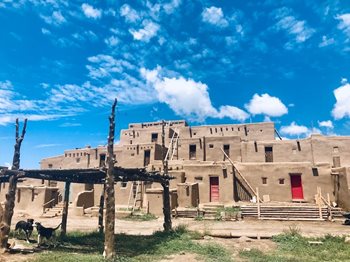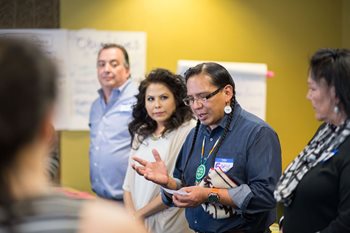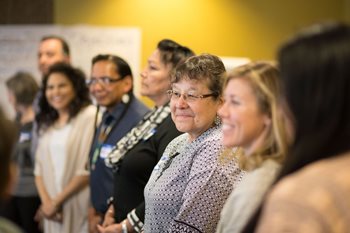Land acknowledgements, practiced for centuries, recognize American Indian and Alaska Natives as stewards of the land. Today, they also serve as an important way to educate the broader community about the land where we live and work – and to remember who came before us, shares Mel Willie, director of Native Partnerships and Strategy at NeighborWorks America.
"It's a way to educate those who may not have thought about the land on which they stand," Willie
 Taos Pueblo. Photo/Mel Willie
says. The acknowledgement is also tied to the Landback Movement, giving Native Americans decision-making power over their land, including sacred land. "It's more than just a statement," Willie says. "It's the beginning of a dialogue."
Taos Pueblo. Photo/Mel Willie
says. The acknowledgement is also tied to the Landback Movement, giving Native Americans decision-making power over their land, including sacred land. "It's more than just a statement," Willie says. "It's the beginning of a dialogue."

Since Willie has been in his role at NeighborWorks, he's received calls from NeighborWorks network organizations asking how to do a proper land acknowledgement, either before a gathering or when dedicating a new project or development. It's a subject he thinks about constantly. The most important part, he says, is for an acknowledgement to be authentic.
"Some people just see it as a check mark. And that's offensive." An acknowledgment should have real meaning and should include research about the tribes who settled in the region. That's a part of creating respectful partnerships.

There are 574 American Indian and Alaska Native tribes in the United States, and their land acknowledgements are as diverse as they are. When working on a land acknowledgment, Willie recommends that participants:
- Make it authentic and heartfelt.
- Show respect.
- Do research; some links are available below.
- Ask Native elders to join.
Stephanie Cote, senior program officer of Financial Education and Asset Building at Oweesta, says her organization delivers land acknowledgements at each training they do, virtual or in person. During the pandemic, most of those trainings have been in places they know well, including Cote's ancestral home in Michigan. When they visit areas she's not as familiar with, she often looks to local colleges for help with research about the land and the tribes that once lived there.
Land acknowledgements, Cote believes, can be delivered by anyone, Native or non-Native. Prayers,
 An Oweesta gathering. Photo/Oweesta
which Oweesta also incorporates into their trainings, should be delivered by someone who is Native or a community elder. "All in all, if you're doing a land acknowledgement, it's better to have done one and fumbled a little as opposed to not doing one at all," says Cote, who is Anishinaabe of the Grand Traverse Band of Ottawa Indians. "Every time I've heard one, I've thought 'Wow. That's awesome.'" Cote included a short workshop on drafting land acknowledgments at NeighborWorks America's Community Leadership Institute during a course on Race, Equity, Diversity and Inclusion.
An Oweesta gathering. Photo/Oweesta
which Oweesta also incorporates into their trainings, should be delivered by someone who is Native or a community elder. "All in all, if you're doing a land acknowledgement, it's better to have done one and fumbled a little as opposed to not doing one at all," says Cote, who is Anishinaabe of the Grand Traverse Band of Ottawa Indians. "Every time I've heard one, I've thought 'Wow. That's awesome.'" Cote included a short workshop on drafting land acknowledgments at NeighborWorks America's Community Leadership Institute during a course on Race, Equity, Diversity and Inclusion.

"The most important reason to do one is recognition, recognizing the land and that there is a history that is tied to the land that has been overlooked for centuries," Cote says.
Willie also emphasizes not waiting until a dedication of a project to bring in the tribal community. "If you're doing a housing project in downtown Chicago, reach out to the community when you're thinking about the plan. When people ask me about land acknowledgements, I say, 'Did you do outreach first?' If you're practicing land acknowledgement, also practice tribal outreach, especially if the housing project involves elderly homes or youth centers, especially if your community has a significant tribal population."
Mel Willie leads NeighborWorks America's Native work and is available as a subject expert.
Mel Willie leads NeighborWorks America's Native work and is available as a subject expert.
Resources for land acknowledgements include:
A map to identify an area's indigenous people.
A map to identify an area's indigenous people.
The NDN Collective

